
Concept explainers
Obtain the equivalent resistance at the terminals a-b for each of the circuits in Fig. 2.115.
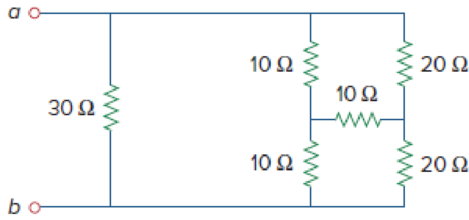
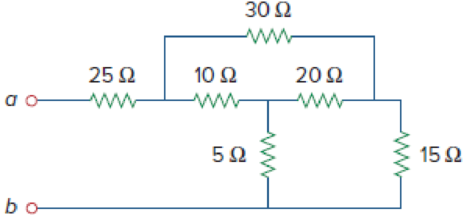
Figure 2.115
(a)
Calculate the equivalent resistance at terminals a-b in Figure 2.115(a).
Answer to Problem 51P
The equivalent resistance at terminals a-b in Figure 2.115(a) is
Explanation of Solution
Formula used:
Consider the following delta to wye conversion, when all branches in a delta consists same value.
Consider the expression for
Here,
Consider the expression for
Calculation:
Refer to Figure 2.115(a) in the textbook For Prob.2.51.
Step 1:
In Figure 2.115(a), convert the wye connection into delta connection.
Substitute
Since all branches values are same in a wye connection that is
Modify Figure 2.115(a) as shown in Figure 1.
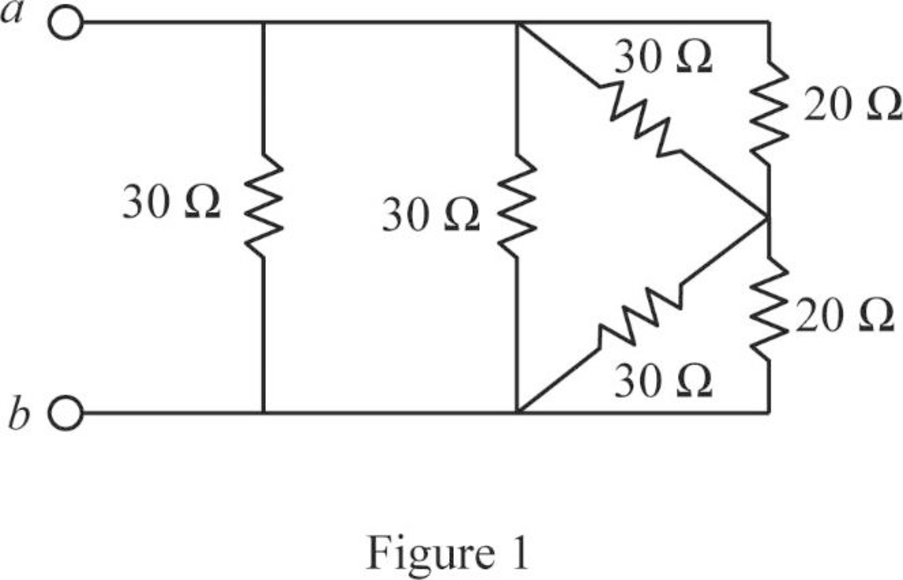
Step 2:
In Figure 1, as
Step 3:
In Figure 1, as
Step 4:
In Figure 1, as
Modify Figure 1 as shown in Figure 2.
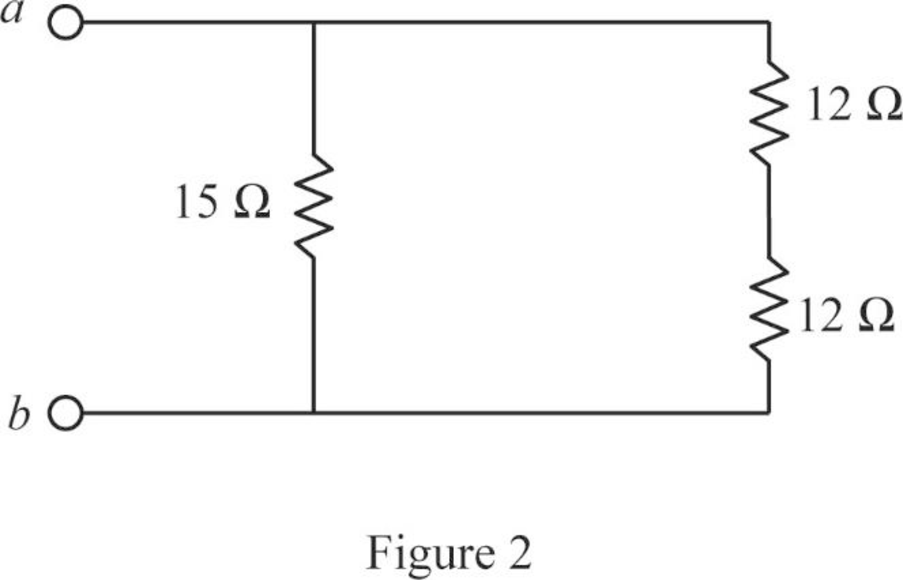
Step 5:
In Figure 2, as two
Modify Figure 2 as shown in Figure 3.
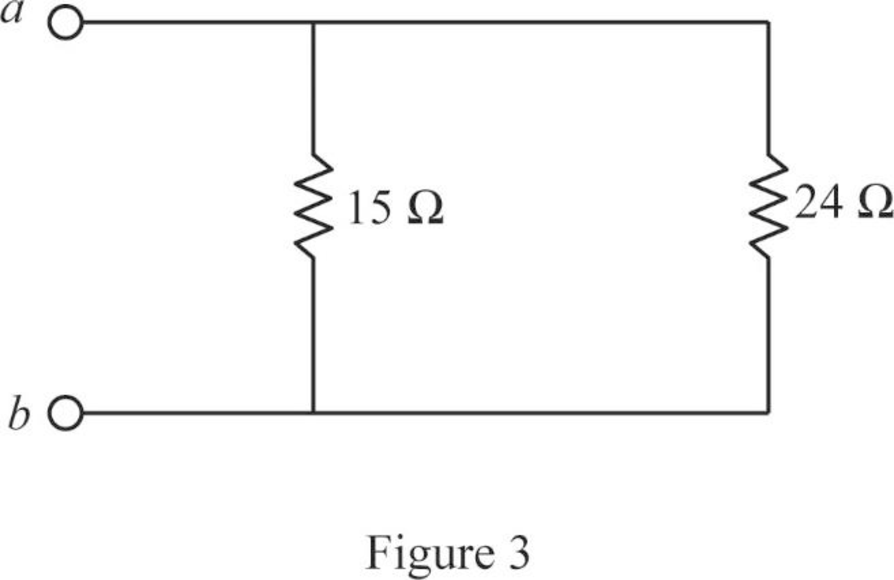
Step 6:
In Figure 3, as
Conclusion:
Thus, the equivalent resistor at terminals a-b in Figure 2.115(a) is
(b)
Calculate the equivalent resistance at terminals a-b in Figure 2.115(b).
Answer to Problem 51P
The equivalent resistance at terminals a-b in Figure 2.115(b) is
Explanation of Solution
Formula used:
Consider the wye to delta conversions.
Here,
Calculation:
Refer to Figure 2.115(b) in the textbook For Prob.2.51.
Step 1:
In Figure 2.115(a), convert the wye connection
Consider
Substitute
Substitute
Substitute
Modify Figure 2.115(b) as shown in Figure 4.
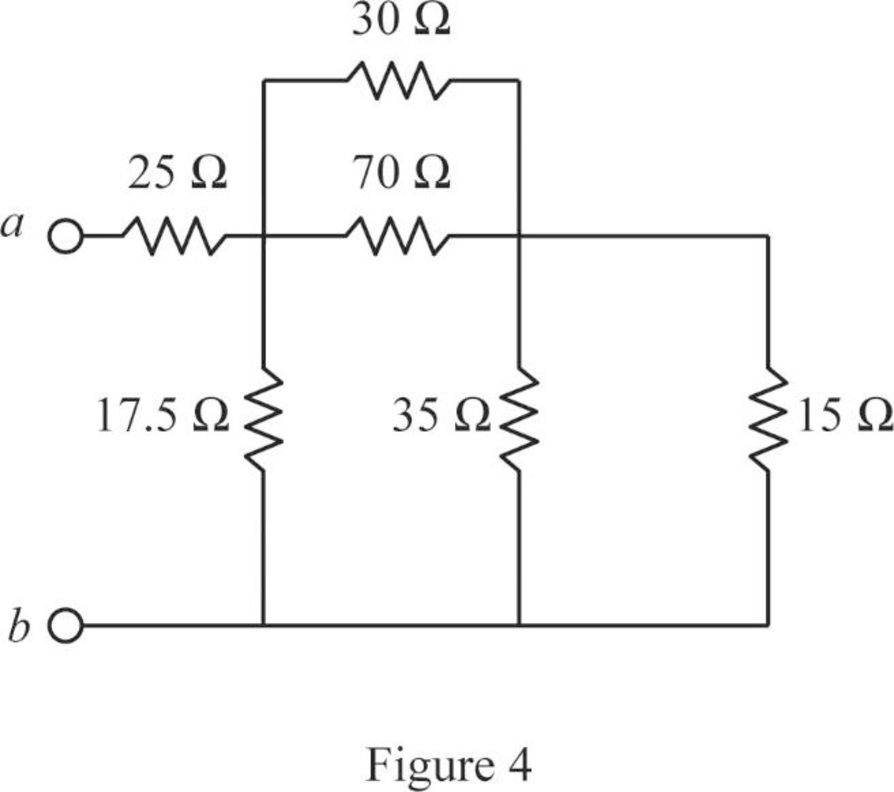
Step 2:
In Figure 4, as
Step 3:
In Figure 4, as
Modify Figure 4 as shown in Figure 5.
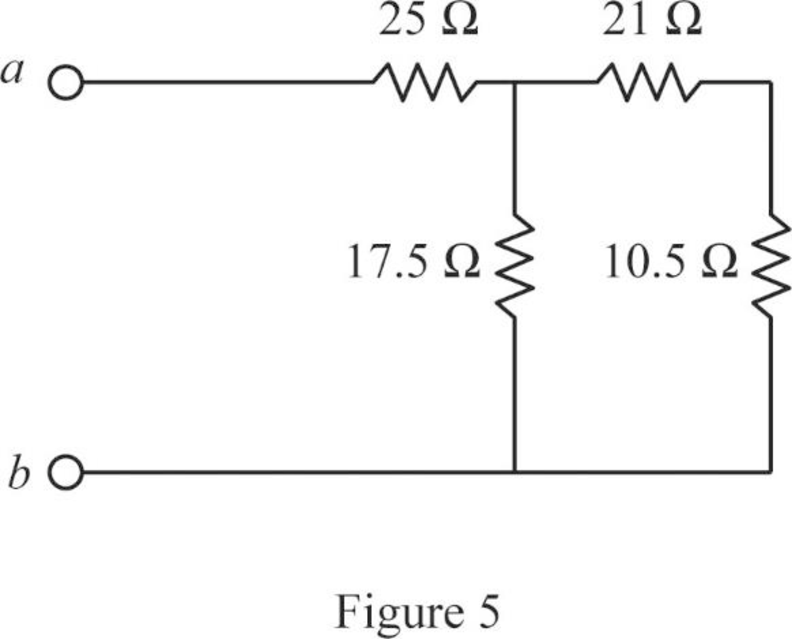
Step 4:
In Figure 5, as
Modify Figure 5 as shown in Figure 6.
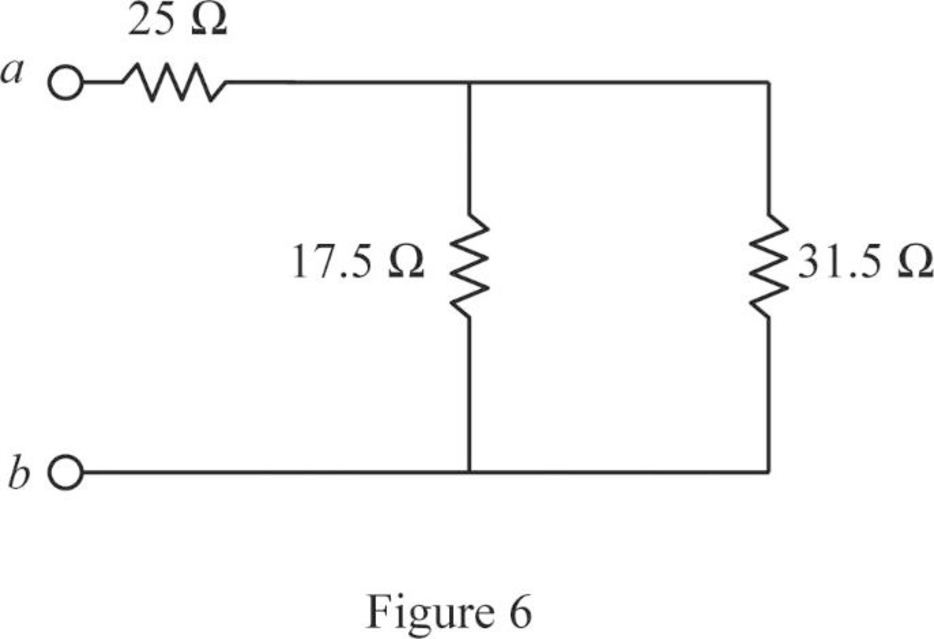
Step 5:
In Figure 6, as
Conclusion:
Thus, the equivalent resistor at terminals a-b in Figure 2.115(b) is
Want to see more full solutions like this?
Chapter 2 Solutions
Fundamentals of Electric Circuits
- Find the inverse of Laplace transform s-1 5+5 , Re[s]>-3 (s+1)(s-3) s+5 a) s²(s+3) b) c) (S-1)(s+1)2 d) s+5 , i) Re[s]> 3 ii) Re[s]-1 ii) Re[s] 1 (s-1)(s-2)(s-3)' , i) Re[s]> 3 ii) Re[s]<1 iii) Iarrow_forward1- Find the Laplace transform and the corresponding ROC of the following signals. a) x(t) = [et + et cos(3t)]u(t) b)x(t) = e-alte-atu(t) + eatu(-t), consider a>0. c) x(t)=8(t) +8(t-1)+8(t−2) d) x(t) = u(-1)-u(1) e) x(t) = e-³t sin(2t)u(t)dr f)x(t) =[r³ +sin(2t)]u(t)dt g)x(t)=t2e2 cos(5t) u(t - 1)arrow_forwardThe transfer function of causal LTI system is H(s) = s+1 (s+1)(s+3) Determine the response y(t) when the input x(t) = elt, for the following region of convergence :) Re[s]> -3 ii) Re[s]Re[s]> -3arrow_forwardConsider the signal y(t) = x₁(t-2) x2(-t + 3) where x₁(t) = e−2tu(t) and x2(t) = eu(t). Determine the Laplace transform of y(t) using the properties. Also find the ROC.arrow_forwardConsider the LTI system with the input x(t) = eu(t) and the impulse response h(t) = e−2tu(t). a) Determine the Laplace transform of x(t) and h(t). b) Using convolutional property, determine the Laplace transform of the output y(t). Find the ROC for each case.arrow_forward2) a) Plot the voltage transfer characteristic of the circuit below. Assume diode and zener are ideal with VDon=0V (20Pts) view 1K 1, B-100, VBE =0,7V ovo VCEsat = 0V, 2K It 10 V 8V zenerarrow_forwardcircuit dchow find vth step by step rth find RL that enables the circuit to deliver maximum power to terminal then plot norton cırcuitarrow_forwardDon't use ai to answer I will report you answerarrow_forwardSA [(a) 5 V (b) 5 V] 13. Find the voltage V in the network shown in Fig. 2.44 (a) if R is 10 2 and (b) 20 2 14. In the network of Fig. 2.44 (b), calculate the voltage between points a and b i.e. Vab [30 V] (Elect. Engg. I, Bombay Univ.) 4A 78A 4 h 10A ww 3A (a) ΤΑ 6A DC Network Theorems SA Is 1A 77 12A www 12 6A 8A Fig. 2.44 (b) [Hint: In the above two cases, the two closed loops are independent and no current passes between them].arrow_forwardarrow_back_iosSEE MORE QUESTIONSarrow_forward_ios
 Introductory Circuit Analysis (13th Edition)Electrical EngineeringISBN:9780133923605Author:Robert L. BoylestadPublisher:PEARSON
Introductory Circuit Analysis (13th Edition)Electrical EngineeringISBN:9780133923605Author:Robert L. BoylestadPublisher:PEARSON Delmar's Standard Textbook Of ElectricityElectrical EngineeringISBN:9781337900348Author:Stephen L. HermanPublisher:Cengage Learning
Delmar's Standard Textbook Of ElectricityElectrical EngineeringISBN:9781337900348Author:Stephen L. HermanPublisher:Cengage Learning Programmable Logic ControllersElectrical EngineeringISBN:9780073373843Author:Frank D. PetruzellaPublisher:McGraw-Hill Education
Programmable Logic ControllersElectrical EngineeringISBN:9780073373843Author:Frank D. PetruzellaPublisher:McGraw-Hill Education Fundamentals of Electric CircuitsElectrical EngineeringISBN:9780078028229Author:Charles K Alexander, Matthew SadikuPublisher:McGraw-Hill Education
Fundamentals of Electric CircuitsElectrical EngineeringISBN:9780078028229Author:Charles K Alexander, Matthew SadikuPublisher:McGraw-Hill Education Electric Circuits. (11th Edition)Electrical EngineeringISBN:9780134746968Author:James W. Nilsson, Susan RiedelPublisher:PEARSON
Electric Circuits. (11th Edition)Electrical EngineeringISBN:9780134746968Author:James W. Nilsson, Susan RiedelPublisher:PEARSON Engineering ElectromagneticsElectrical EngineeringISBN:9780078028151Author:Hayt, William H. (william Hart), Jr, BUCK, John A.Publisher:Mcgraw-hill Education,
Engineering ElectromagneticsElectrical EngineeringISBN:9780078028151Author:Hayt, William H. (william Hart), Jr, BUCK, John A.Publisher:Mcgraw-hill Education,





